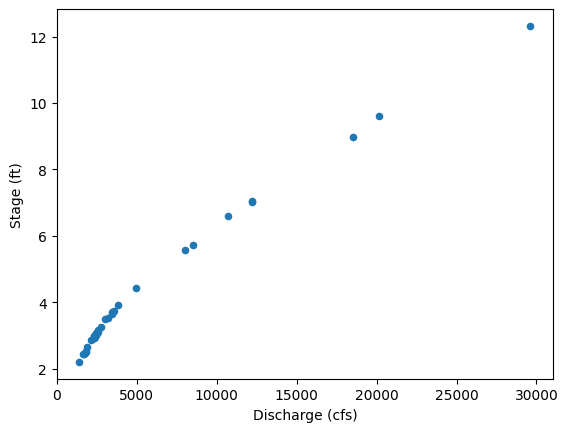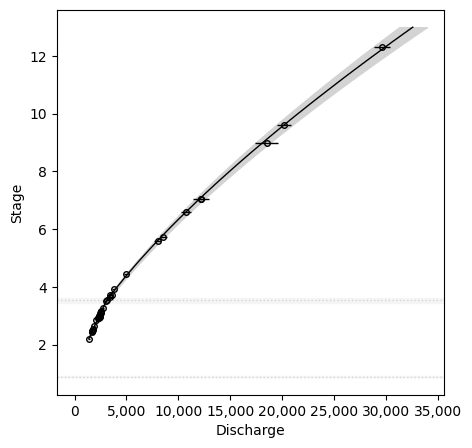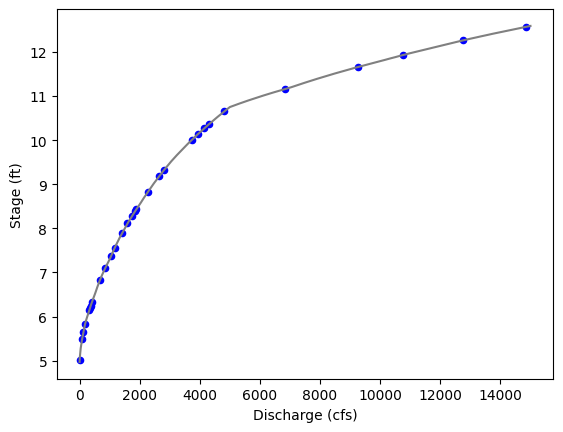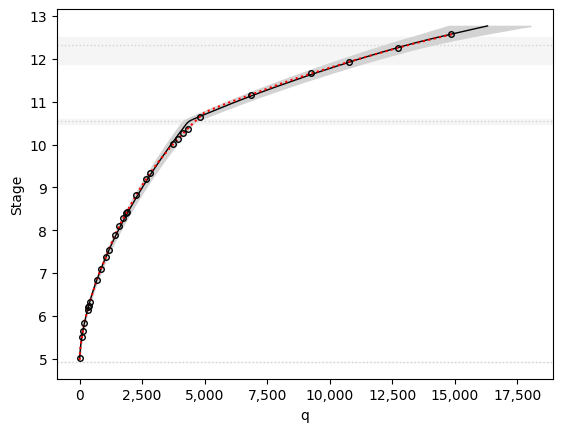Segmented Power Law#
There are several approaches to fitting a stage-discharge rating curve. This notebook demonstrates an simple way to approximate the classic approach, which uses a segmented power law.
# Uncomment below to setup Google Colab. It will take a minute or so.
# %%capture
# !pip install pymc==5.1.2
# %env MKL_THREADING_LAYER=GNU
# !pip install git+https://github.com/thodson-usgs/ratingcurve.git
%load_ext autoreload
%autoreload 2
import pymc as pm
import arviz as az
from ratingcurve.ratings import PowerLawRating
WARNING (pytensor.tensor.blas): Using NumPy C-API based implementation for BLAS functions.
Load Data#
Begin by loading the Green Channel dataset
from ratingcurve import data
df = data.load('green channel')
df.head()
| datetime | stage | q | q_sigma | |
|---|---|---|---|---|
| 0 | 2020-05-21 14:13:41 [UTC-07:00] | 7.04 | 12199.342 | 199.172931 |
| 1 | 2020-04-16 14:55:31 [UTC-07:00] | 4.43 | 4921.953 | 95.425619 |
| 2 | 2020-03-04 13:54:10 [UTC-07:00] | 2.99 | 2331.665 | 61.860500 |
| 3 | 2020-03-04 13:16:51 [UTC-07:00] | 2.94 | 2289.220 | 47.886745 |
| 4 | 2020-01-23 11:04:32 [UTC-07:00] | 2.96 | 2408.210 | 99.522964 |
and plotting the observations.
ax = df.plot.scatter(x='q', y='stage', marker='o')
ax.set_xlabel("Discharge (cfs)")
ax.set_ylabel("Stage (ft)")
Text(0, 0.5, 'Stage (ft)')

Setup model#
Now, setup the rating model. This make take a minute the first time while the model compiles but will be faster on subsequent runs.
powerrating = PowerLawRating(segments=2,
prior={'distribution':'uniform'})
There are of variety of ways to adjust the optimization. Here we’ll use the defaults, which uses ADVI and runs for 200,000 iterations, though the model should coverge well before that.
trace = powerrating.fit(q=df['q'],
h=df['stage'],
q_sigma=df['q_sigma'])
/opt/hostedtoolcache/Python/3.11.9/x64/lib/python3.11/site-packages/rich/live.py:231: UserWarning: install
"ipywidgets" for Jupyter support
warnings.warn('install "ipywidgets" for Jupyter support')
Convergence achieved at 139500
Interrupted at 139,499 [69%]: Average Loss = 40.4
Sampling: [a, b, hs_, model_q, sigma]
Sampling: [model_q]
/opt/hostedtoolcache/Python/3.11.9/x64/lib/python3.11/site-packages/rich/live.py:231: UserWarning: install
"ipywidgets" for Jupyter support
warnings.warn('install "ipywidgets" for Jupyter support')
Once fit, we can plot the rating curve.
powerrating.plot()
Sampling: [model_q]
/opt/hostedtoolcache/Python/3.11.9/x64/lib/python3.11/site-packages/rich/live.py:231: UserWarning: install
"ipywidgets" for Jupyter support
warnings.warn('install "ipywidgets" for Jupyter support')

or as a table of stage-discharge values.
table = powerrating.table()
table.head()
Sampling: [model_q]
/opt/hostedtoolcache/Python/3.11.9/x64/lib/python3.11/site-packages/rich/live.py:231: UserWarning: install
"ipywidgets" for Jupyter support
warnings.warn('install "ipywidgets" for Jupyter support')
| stage | discharge | median | gse | |
|---|---|---|---|---|
| 0 | 2.21 | 1384.055929 | 1383.631462 | 1.017378 |
| 1 | 2.22 | 1396.196507 | 1395.951473 | 1.017410 |
| 2 | 2.23 | 1408.403309 | 1408.008281 | 1.017098 |
| 3 | 2.24 | 1420.336842 | 1420.002411 | 1.017101 |
| 4 | 2.25 | 1432.380651 | 1431.898741 | 1.017345 |
Exercise#
What happens if we choose the wrong number of segments? Increase the number of segments by one and rerun the model. In fact, we can use this to select the correct number of segments, which is demonstrated in the model evaluation notebook.
Simulated Example#
This example uses a simulated rating curve, which allows you to test how changing the number of segments affects the rating curve.
First, load the ‘3-segment simulated’ tutorial dataset.
sim_df = data.load('3-segment simulated')
This rating contains observations of every 0.01 inch. increment in stage, which is much more than we’d have for a natural rating.
Try sampling to n_sample=15 or n_sample=30 and see how that affects the model fit.
# subsample the simulated rating curve
n_sample = 30
df = sim_df.sample(n_sample, random_state=12345)
ax = sim_df.plot(x='q', y='stage', color='grey', ls='-', legend=False)
df.plot.scatter(x='q', y='stage', marker='o', color='blue', ax=ax)
ax.set_xlabel("Discharge (cfs)");
ax.set_ylabel("Stage (ft)");

Setup a rating model with 3 segments
powerrating = PowerLawRating(segments=3,
prior={'distribution':'uniform'},
#prior={'distribution':'normal', 'mu':[5, 8, 11], 'sigma':[1, 1, 0.2]}
)
now fit the model using ADVI
trace = powerrating.fit(q=df['q'],
h=df['stage'],
q_sigma=None,
method='advi')
/opt/hostedtoolcache/Python/3.11.9/x64/lib/python3.11/site-packages/rich/live.py:231: UserWarning: install
"ipywidgets" for Jupyter support
warnings.warn('install "ipywidgets" for Jupyter support')
Finished [100%]: Average Loss = -48.508
Sampling: [a, b, hs_, model_q, sigma]
Sampling: [model_q]
/opt/hostedtoolcache/Python/3.11.9/x64/lib/python3.11/site-packages/rich/live.py:231: UserWarning: install
"ipywidgets" for Jupyter support
warnings.warn('install "ipywidgets" for Jupyter support')
and visualize the results.
import matplotlib.pyplot as plt
fig, ax = plt.subplots()
powerrating.plot(ax=ax)
# plot the original data for comparison
sim_df.plot(x='q', y='stage', color='red', ls=':', legend=False, ax=ax)
Sampling: [model_q]
/opt/hostedtoolcache/Python/3.11.9/x64/lib/python3.11/site-packages/rich/live.py:231: UserWarning: install
"ipywidgets" for Jupyter support
warnings.warn('install "ipywidgets" for Jupyter support')
<Axes: xlabel='q', ylabel='Stage'>

powerrating.summary(var_names=["b", "a", "sigma", "hs"])
arviz - WARNING - Shape validation failed: input_shape: (1, 10000), minimum_shape: (chains=2, draws=4)
| mean | sd | hdi_3% | hdi_97% | mcse_mean | mcse_sd | ess_bulk | ess_tail | r_hat | |
|---|---|---|---|---|---|---|---|---|---|
| b[0] | 0.984 | 0.002 | 0.980 | 0.988 | 0.000 | 0.000 | 9598.0 | 9163.0 | NaN |
| b[1] | 0.353 | 0.008 | 0.338 | 0.368 | 0.000 | 0.000 | 9792.0 | 9747.0 | NaN |
| b[2] | 0.049 | 0.056 | -0.055 | 0.155 | 0.001 | 0.000 | 10085.0 | 9675.0 | NaN |
| a | -1.007 | 0.003 | -1.013 | -1.002 | 0.000 | 0.000 | 9838.0 | 9719.0 | NaN |
| sigma | 0.015 | 0.002 | 0.012 | 0.019 | 0.000 | 0.000 | 9832.0 | 9679.0 | NaN |
| hs[0, 0] | 4.928 | 0.001 | 4.926 | 4.930 | 0.000 | 0.000 | 10334.0 | 10066.0 | NaN |
| hs[1, 0] | 10.545 | 0.032 | 10.486 | 10.607 | 0.000 | 0.000 | 9758.0 | 10008.0 | NaN |
| hs[2, 0] | 12.317 | 0.166 | 12.024 | 12.532 | 0.002 | 0.001 | 9858.0 | 9659.0 | NaN |
Fitting this model can be tricky. The most common issue is a poor initialization of the breakpoints. A fix is under development, but for now, try
reinitializing the model
PowerLawRating();increasing the number of iterations for the fitting algorithm
fit(n=300_000);a prior on the breakpoints, example, try
prior={'distribution':'normal', 'mu':[5, 9.5, 10.5], 'sigma':[1, 1, 0.2]}), which implies we know the true breakpoint within +-0.5 ft; orfitting the model with NUTS
fit(method='nuts').
%load_ext watermark
%watermark -n -u -v -iv -w -p pytensor,xarray
Last updated: Mon Jun 03 2024
Python implementation: CPython
Python version : 3.11.9
IPython version : 8.25.0
pytensor: 2.22.1
xarray : 2024.5.0
matplotlib : 3.9.0
pymc : 5.15.1
arviz : 0.18.0
ratingcurve: 0.1.dev1+g54c5899
Watermark: 2.4.3